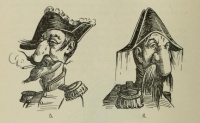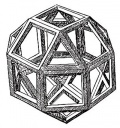Cocaine
From The Art and Popular Culture Encyclopedia
|
Way in my brain, no cocaine I don't wanna, I don't wanna go insane. --"Under Mi Sleng Teng" (1995) - Wayne Smith "Robert Louis Stevenson was another great discovery for me - the notion that the story of Jekyll and Hyde had emerged from a cocaine binge makes so much sense of the story itself, as well as serving as a great example of the subtle ways in which an illicit drug like cocaine has found its way into mainstream culture." -- Sadie Plant [1] "The basic tenet proposed by J. V. Scheidt states that the narcotic drug, cocaine played a role in the development of psychoanalysis which has been underestimated up to the present day."[2] See Freud and cocaine. |

Illustration: Napoleon III nose caricatures from Schneegans's History of Grotesque Satire
|
Related e |
|
Featured: |
Cocaine is a stimulant narcotic in the form of a white powder that users generally self-administer by insufflation through the nose.
It is obtained from the leaves of the South American coca plant. It is a stimulant of the central nervous system and an appetite suppressant, giving rise to what has been described as a euphoric sense of happiness and increased energy. It is most often used recreationally for this effect. Nonetheless, cocaine is formally used in medicine as a topical anesthetic, specifically in eye, nose and throat surgery.
In modern Western countries, cocaine has been a feature of the counterculture for over a century. There is a long list of prominent intellectuals, artists, politicians, and musicians who have used the drug, ranging from Sir Arthur Conan Doyle and Sigmund Freud to former U.S. President Ulysses S. Grant.
Its possession, cultivation, and distribution are illegal for non-medicinal and non-government sanctioned purposes in virtually all parts of the world. Although its free commercialization is illegal and has been severely penalized in virtually all countries, its use worldwide remains widespread in many social, cultural, and personal settings.
Contents |
Cocaine in literature
By the late Victorian era cocaine use had appeared as a vice in literature, for example as the cucaine injected by Arthur Conan Doyle’s fictional Sherlock Holmes.
Titles
- Cocaina, 1921, an Italian novel by Pitigrilli
- Cocain, 1921, a German novel by Franz Wolfgang Koebner
- Cocain Romance, 1934, a Russian novel by M. Ageyev
See also
Cocaine in music
- "Cocaine in My Brain", a song by Dillinger
- "Cocaine Decisions", a song by Frank Zappa
See also

